22 Best Exercises For Weight Loss
Introduction:
Exercise promotes metabolism, improves general health, tones muscles, and burns calories. Combining cardiovascular, strength, and flexibility activities can create a complete exercise program that promotes weight loss goals.
In this article, we will look at some Exercises For Weight Loss. It’s crucial to remember that, even while exercise is a big part of losing weight, for best effects, it should be combined with food and lifestyle choices. Furthermore, it’s wise to speak with your physician before beginning a new workout program, particularly if you have any underlying medical issues or concerns.
No matter how experienced you are with fitness, this guide will provide you with a variety of workouts and tips to help you develop a weight-loss training program. Start at a level that is comfortable for you and progressively raises the intensity and duration of the exercises as you gain strength and endurance since regularity and gradual improvement are crucial.
To help you achieve your fitness goals and begin leading a healthy lifestyle, let’s begin by learning about the different components of an Exercises For Weight Loss program, such as aerobic, strength, and flexibility exercises.
Advantages of Exercise:
- It increases your rate of metabolism.
- It makes the heart stronger and more capable of pumping blood.
- Through fat burning, it helps in weight loss.
- Reduces the chance of both high blood pressure and heart attacks.
- Increases the density of bone.
- Helps to strengthen your circulatory system and increase blood flow.
- Increases lung capacity and facilitates better breathing.
- It improves coordination and balance.
- Helps reduce stress and elevate mood.
Exercises For Weight Loss:
Walking
- Walking is easy, which makes it fun for many people, especially those who wish to burn more calories.
- In addition to your age and sex, the environment and atmosphere also affect how many calories you burn.
- If you wish to walk every day for exercise, start modestly and work your way up to longer walks and more frequent walks. The difficulty can be increased once you can walk for as long and as often as you choose.
- Your ability to lose weight may also be impacted by the frequency and amount of your walks. Walking is beneficial for weight loss, but it works best when combined with a calorie-restricted diet.
- Additionally, many people lose their muscle mass as they lose weight. Walking maintains muscle mass and will help you keep losing weight.

Cycling
- One of the best methods to burn hundreds of calories while working out is to ride a bicycle.
- 30 minutes of cycling per day resulted in a greater reduction in weight than either easy walking or no activity, and the advantages of cycling as a weight-control method were much greater for overweight people.
- One of the best ways to burn a lot of calories without spending a lot of time in the gym is to ride a bicycle.
- Start by exercising moderately, then increasing the length of your sessions or the intensity of your efforts.
- You can improve your level of fitness, burn more calories, and lower your risk of common health problems by engaging in three to five 30-minute moderate cycling sessions per week.
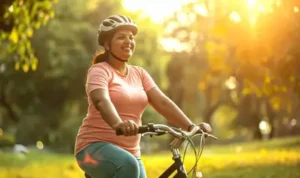
Jump Rope
- Put yourself in an upright position with your back straight and your core strong.
- In each hand, hold one handle.
- As you swing the rope forward, maintain your elbows at waist level.
- Leap as soon as the rope touches the ground in front of you.
- Your heart rate will increase as you move at a speed that suits you.
- Continue jumping for a minute.
- Then return to your neutral position.
- Then relax.
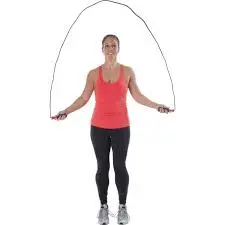
Jumping Jacks
- Initially, stand with your arms by your sides and your legs upright.
- Stretch your feet more than hip-width apart and lift your arms over your head until they nearly touch.
- With your legs coming together and your arms lowering, jump once more.
- Then return to your neutral position.
- Then relax.
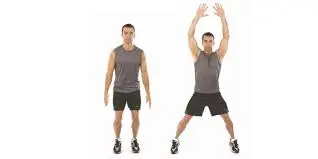
Jump Squats
- Step one is to stand on the ground.
- Flex your knees to go into a complete squat position.
- Raise your body off the ground and extend your legs by using your quadriceps, hamstrings, and glutes.
- When the legs are fully stretched, the feet will be at least a couple of inches above the ground.
- Drop into the squat once again for another strong jump, controlling your landing by traveling through your foot (toes, arches, heel).
- After you land, immediately do the following jump.
- Then return to your neutral position.
- Then relax.
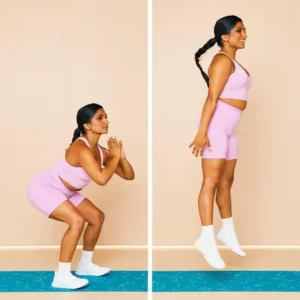
Butt kicks
- Standing upright on the ground’s surface is the initial step.
- Slowly contract your hamstrings to bring your right heel near your buttocks.
- Hold this position for a few seconds.
- After putting your right foot’s heel back on the ground, gradually raise your left foot’s heel to your buttocks.
- Repeat this movement several times, switching heels and progressively increasing your speed.
- Increase your speed and continue switching between your left and right heels when it seems like you’re jogging in place.
- While doing this, lift your arms to work your upper body together.
- Make a 90-degree extension with your right arm if your left heel is kicking your legs.
- Your left arm should be pulled forward if your right heel is lifting.
- Then return to your neutral position.
- Then relax.
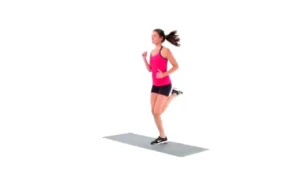
Donkey kicks
- Place your hands beneath your shoulders, leave your neck and spine neutral, and place your legs hip-width apart to begin.
- One leg should be extended back and toward the ceiling while the other knee remains bent.
- The bottom of your foot or shoe should be “looking” at the ceiling.
- For a few seconds, maintain this position while concentrating on squeezing your gluteal muscles.
- Your hip and core muscles may also feel active.
- Then return to your neutral position.
- Then relax.
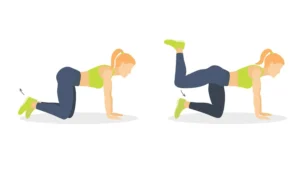
Mountain Climbers
- Place yourself in a plank position, distributing your weight equally between your hands and toes.
- Verify proper form by placing your hands shoulder-width apart, keeping your back flat, contracting your abs, and aligning your head.
- Try to get your right knee as close to your chest as you can.
- Change your legs by pulling one knee in and removing the other.
- As quickly and as far as you can, run your knees in and out while keeping your hips down.
- Breathe in and out alternately on every leg change.
- Then return to your neutral position.
- Then relax.
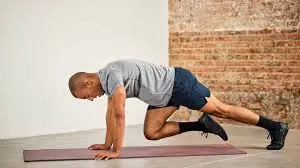
High-knee running
- Maintain a hip-to-shoulder-width distance between your feet and your arms by your sides while standing upright.
- Maintain a forward gaze while engaging your core.
- To start, raise your right knee just above waist level and bring it toward your chest.
- At the same time, make an exhalation movement with your left hand.
- Drop your left hand and right leg as fast as possible.
- Keep moving your left leg and right hand.
- Spend some time alternating from your right and left legs.
- Then return to your neutral position.
- Then relax.

Flutter Kicks
- Be sure to lie down on a yoga mat or another soft surface that you can comfortably lie on.
- Put your palms flat beneath your hips or glutes to stabilize your pelvis and help you lift your body, especially if you’re just starting.
- To work your core and ensure that you feel the action in your abs, pull your abdominal muscles inward and push your belly button into your spine.
- Raise your legs upward while keeping your lower back flat on the floor and your core pulled and braced.
- While working, try to maintain a position that is between 30° and 45° above the ground.
- Beginning with your legs straight and moving slowly, begin fluttering them as though you were swimming, but in the air.
- Breathe in and out with each flutter to ensure that your breathing pattern is under control.
- Then return to your neutral position.
- Then relax.

Bicycle Crunches
- To begin, lie comfortably on your back on the ground.
- To maintain the stability of your spine, you must tighten your core muscles and draw in your abdominal muscles.
- Carefully rest your hands on your head and keep it there.
- Gradually raise your knees to a 90-degree angle by pulling your feet off the floor with your shoulders in the air.
- Exhale, then slowly do a bicycle pedal motion, keeping both legs raised above your hips.
- The first knee should remain fixed as you raise the other to your chest.
- Turn your body such that you can contact the opposing knee as it rises with your elbow.
- With one leg extended and the other knee pulled toward the base of your arm, rotate to the opposite side until your elbow meets the opposing knee.
- Then return to your neutral position.
- Then relax.

Burpees
- Make sure your feet are shoulder-width apart.
- While bringing your butt down, bend your knees such that they extend just past your toes.
- On the floor, keep your feet flat.
- Hold your arms in place.
- Maintain a straight head and slightly forward-facing gaze.
- Bring your body closer to the floor while keeping your elbows flexed.
- Make sure your core is tight and your body is straight.
- Pay attention to maintaining a straight body.
- Leap ahead with your legs.
- Make an effort to touch down with both feet level on the ground.
- Once your arms are raised, turn your body so it faces the ceiling.
- Then return to your neutral position.
- Then relax.
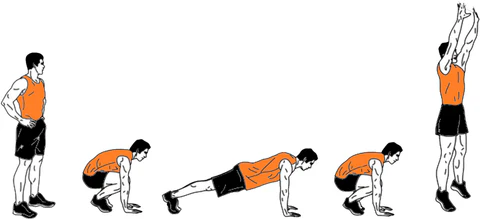
Side Lunges
- To begin, place your feet shoulder-width apart.
- Step outside with one leg wide.
- With your hips extended back and your knee bent at a 90-degree angle, make sure your thigh is parallel to the horizontal.
- Make sure your unmoving foot is straight and touching the ground.
- Hold this position for a few seconds.
- Then return to your neutral position.
- Then relax.
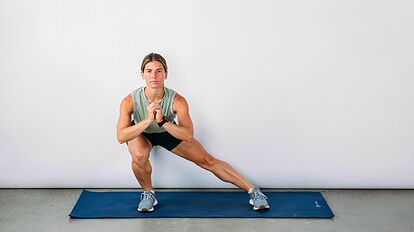
Jumping Lunges
- Start with taking a standing position on the ground.
- Use your feet to hold the floor and equally distribute your weight for stability.
- To start pressing forward, take a stride forward while keeping your spine neutral.
- To drop your hips toward the floor until your back knee is an inch or two off the ground, bend your hips, knees, and ankles while keeping your feet firmly planted.
- Your heel should be off the ground and on the heel of your back foot with your rear hip above your knee.
- Start your jump by throwing your arms forward and pushing your front foot into the ground strongly.
- Change the position of your legs in the air at the height of your jump by moving your forward leg back and your back leg forward.
- Once you’ve jumped, land in the bottom position of the lunge.
- The same techniques should be used for landing and jumping.
- Ensure that your front foot bears a comparable portion of your weight.
- You want your chest to be just a little bit higher than your hips.
- Quickly get ready to jump again after stabilizing your body.
- Keep jumping and switching sides for as many repetitions as you want.
- Then return to your neutral position.
- Then relax.
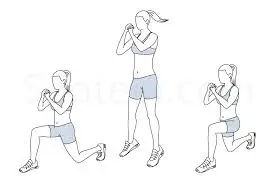
Russian Twist
- To obtain a sense of the movement, beginners can either extend their feet straight out or press them onto the floor.
- Take deep, consistent breaths. After each twist, release your breath and take another one to get back to the center.
- Sitting on the ground with flat feet.
- Your heels must stay on the ground, but your toes may be elevated.
- Your glutes should be squeezed for stability.
- Make a perfect angle between the abdomen and thigh by leaning back.
- Extend your arms in front of yourself.
- During the activity, keep your eyes on your hands.
- With every repetition, move your body from side to side, stopping for a moment in the middle.
- Slowly move while maintaining eye contact with the weight.
- You’ve gone too far if your hips and knees start to shift; just work within your range of motion.
- Then return to your neutral position.
- Then relax.

Plank Pose
- To ensure that you are comfortable while on all fours, use an exercise mat or yoga mat.
- Put your forearms and toes face down on the floor to start in the plank position.
- The elbows directly rest behind the shoulders when the forearms are pointed forward.
- Your belly should be drawn closer to your spine as you contract your abdominal muscles.
- Keep your shoulders down so they do not extend up into your ears.
- Your heels ought to be higher than your toes.
- Hold this position for a few seconds.
- Then return to your neutral position.
- Then relax.
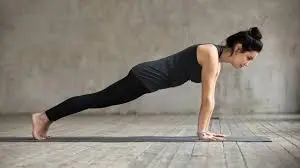
Triangle Pose
- Maintain a straight standing posture.
- At this point, line up the middle of your right heel with the middle of your left foot arch.
- Make sure your entire weight is evenly distributed across both feet and that your feet are pressing the ground.
- After taking a deep breath, bend your body to the right, lowering it from the hips while maintaining a straight waist.
- This will allow your left hand to rise into the air while your right-hand lowers toward the floor.
- Maintain a straight line with both arms.
- Without causing any changes to the sides of your waist, place your right hand on your shin, ankle, or the floor outside your right foot.
- Raise your left arm toward the sky until the tops of your shoulders make contact with it.
- Maintain a neutral head posture or tilt it to the left while gently staring at the left palm.
- Make sure your body is bending sideways rather than forward or backward. The chest and pelvis are exposed.
- Stretch as much as you can while remaining stable.
- Continue inhaling deeply and slowly.
- With every breath, keep your body relaxed.
- Lift yourself, lower your arms to your sides, and straighten your feet as you take a breath.
- Then return to your neutral position.
- Then relax.
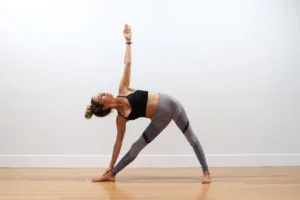
Bridge Pose
- Place yourself on your back with your knees bent.
- Your fingertips should touch the back of your heels as you spread your feet hip-width apart.
- Without putting undue strain on your glutes, exert pressure with your hands and feet to lift your hips off the floor.
- Hold this position for a few seconds.
- Lower your hips down.
- Then return to your neutral position.
- Then relax.
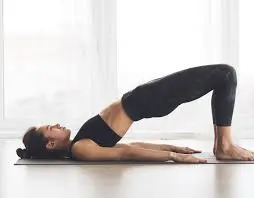
Squat-Overhead-Press
- With your elbows close to your body, take one dumbbell in both hands, with the palms towards each other, standing in front of each shoulder.
- Keep the weights on your front shoulders as you lower yourself into a squat.
- To get out of a squat, press both legs into the floor, straighten your arms, and raise the dumbbells above your head.
- Hold this position for a few seconds.
- Gently put the weights back on your shoulders.
- Then return to your neutral position.
- Then relax.
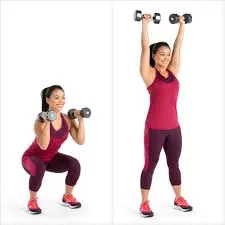
Downward Facing Dog Pose (Adho Mukha Svanasana)
- Get down on your hands and knees on the floor to begin.
- On the mat, place your hands shoulder-distant from one another.
- External rotation of the arms can be achieved by pulling the quadriceps back so that the elbows face toward the back of the space.
- After curling your toes under, lift your knees, hips, and back.
- Raise yourself from the pelvis and press into your hands to extend your spine.
- Create space across your back by pulling your steps down.
- Turn your heels out to place them behind your toes and lift them a little.
- Squeeze the thigh within of you.
- Make sure your ears are in line with your biceps by bringing your gaze straight down.
- Then return to your neutral position.
- Then relax.
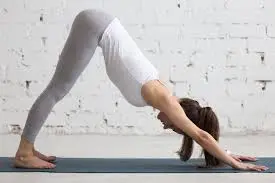
Warrior I Pose (Virabhadrasana)
- Begin by standing comfortably on the floor.
- Depending on how long your legs are, after you exhale, step your left foot back around a meter.
- Ensure that your legs are on two different lines and that your left toes are at a 45-degree angle.
- To engage via this leg, pull up the muscles above your left kneecap. Then, give a firm squeeze via your left foot’s little toe side.
- Make sure your right knee aligns with your right hip and toes by bending down into it.
- Try to align your shoulders and hips to the top of your mat, and push your pelvis under a little to extend down to the tailbone.
- As you breathe in, lift your arms into the air.
- You can either keep your arms shoulder-width apart or put your palms together.
- Looking forward or up at your thumbs will keep your head in a neutral position.
- Keep your shoulders back from your ears, contract your core, maintain a firm posture through both legs, and experience a lift that travels up your arms, through your chest and abdomen, and into your legs.
- Hold this position for a few seconds.
- Then return to your neutral position.
- Then relax.

Standing Forward Bend Pose (Uttanasana)
- Stand on the ground at the beginning of the exercise.
- Raise your arms and inhale.
- As you exhale, contract your thighs, bend forward, and hinge from the hips, pulling the belly in and up deep into the pelvic floor.
- Place your hands or fingers on the floor in front of or next to your feet, or hold onto the back of your calves or ankles.
- Pull the upper part of your inner thighs in a little.
- Lean back and let your head rest.
- Inhale and lengthen your spine.
- Hold this position for a few seconds.
- With each exhale, move yourself further into the position.
- Then return to your neutral position.
- Then relax.
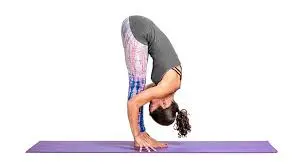
What precautions need to be taken when working out?
- When you start any exercise, warm up and stretch.
- Make sure your posture is correct when working out.
- Eat something light before working out. Avoid eating immediately after working out and working out when you’re hungry.
- To keep from falling when exercising, keep your eyes on yourself and stay focused.
- To get the most benefit of your training, dress comfortably and loosely so that you may relax and move to your fullest. Avoid tight or overly fashionable clothing.
- Avoid making abrupt or violent movements during exercise.
- Take a break in between workouts.
- Stay hydrated.
When are you going to stop working out?
- Fever
- Intense burning in the muscles.
- Your health is not good.
- Exercise should be stopped if it causes pain.
- Headache
Summary:
Reducing body weight, typically by fat reduction, is the main objective of weight loss. A lot of people do it to manage certain medical conditions, improve their physical appearance, or get healthier overall. Although weight loss can be achieved in many ways, the basic idea is to create a calorie deficit that is, to consume fewer calories than the body uses.
To reduce weight, people might focus on applying a combination of dietary changes, increased activity, and good lifestyle choices.
FAQ:
Which exercise is ideal for losing weight?
The most effective weight-loss plan combines strength training and cardiovascular activity. Circuit training, high-intensity interval training (HIIT), and aerobic exercises like swimming, cycling, or running are good ways to burn calories and lose weight.
Does losing weight require me to attend a gym?
No, there are other ways to lose weight than attending the gym. Bodyweight exercises, running, cycling, and watching internet fitness videos are just a few of the workouts you can perform at home or outside. On the other hand, gyms can give you access to a range of tools and programs that could help you lose weight.
Which time of day is better for exercising to lose weight morning or evening?
The ideal time to work out is when you can focus on your fitness regimen consistently. Maintaining regularity and consistency in your exercise routine is crucial, regardless of whether you go for morning or evening workouts.
How can I maintain my motivation to complete my weight loss exercises?
Setting reasonable objectives, monitoring your progress, figuring out an exercise regimen you love, and enlisting the help of friends or a workout partner can all help you stay motivated. Change up your workouts, acknowledge your accomplishments, and remind yourself that regular exercise is good for your physical and emotional health.
Should I follow a certain diet in addition to my exercise program to lose weight?
While exercise on its own can help people lose weight, it works best when combined with a nutritious, well-balanced diet. To establish a calorie deficit, consume less fat than you expend through everyday activity and exercise. Speak with a licensed dietitian or nutritionist for individualized nutritional guidance.
What is the most fat-burning exercise?
No workout burns more calories in an hour than running. Swimming, walking, and stationary cycling are other great choices. High-intensity interval training exercises are excellent for burning calories as well. Your body will continue to burn calories for up to 24 hours following a high-intensity interval training activity.
Is metabolism increased by exercise?
Regular exercise indeed raises your resting metabolic rate. This implies that your body will grow better at burning calories and utilizing the excess energy for maintaining your activities. In light of this, continue reading to find out more about ways that can improve your resting metabolism.
References:
- On July 20, 2023, Sutariya, H. Here are the top 31 at-home workouts for weight loss and fat reduction. Physiotherapy Clinic of Samarpan. Physioclinic.com/31-best-weight-loss-exercises/
- June 11, 2023: Patel, D. Most Effective 34 Workout for Burning Calories by Samarpan Physio. clinic for physical therapy in Samarpan. For speedy calorie burning, check out the best 34 workouts at https://samarpanphysioclinic.com/.
- Image 1, On May 16, 2024, Bumgardner, W. Does Excessive Walking Have an Adverse Effect? Very well-fitting. How much walking is too much? https://www.verywellfit.com/?-3975564
- Image 2, Does Riding a Cycle Help You Lose Weight? On July 26, 2024, Hero Cycles. Cycles for weight loss: https://www.herocycles.com/blog/doing it
- Image 3, (n.d.) Jumping Rope. UK’s Pure2Improve. Jump training: https://www.pure2improve.co.uk/5026-jumping-rope-8719407033994.html
- Image 4, FitPass (n.d.). You May Not Have Known These 9 Health Benefits of Jumping Jacks. FITPASS. https://fitpass.co.in/blog/9-health-benefits-of-jumping-jacks-you-were-disregardless
- Image 5, May 23, 2024; Mazzo, L. Jump Squat Techniques. pop sugar. How to perform jump squats (https://www.popsugar.com/fitness/999573)
- Image 6, On October 7, 2014, LivestrongWoman. Butt Kicks [Video]. https://www.youtube.com/watch?v=-dtvAxibgYQ for YouTube
- Image 7, As of March 22, 2024, Vlce, K. A. M. C. How to Perform Donkey Kicks to Strengthen Your Arms, Core, and Glutes. Very easy. Donkey-kick exercise form https://www.realsimple.com/health/fitness-exercise
- Image 8, P. Dhar (2023, Sept. 29). What makes mountain climbers necessary? Fitness-mountain-climbers-core-exercise-111695909843568.html Mintlounge. https://lifestyle.livemint.com/health/fitness
- Image 9, Exercises intended to enhance technique are known as running training. (n.d). Sports Performance Bulletin. https://www.sportsperformancebulletin.com/training/running-training-workouts-crafted-to-improve-technique
- Image 10, As of September 11, 2023, DMoose. Kicks for Flutter. @dmoose.com/blogs/abs/flutter-kicks
- Image 11, March 7, 2024: Schuler, M. A Guide to Cycling Crunches. BOD. Bicycle crunches’ blog: https://www.beachbodyondemand.com
- Image 12, March 24, 2022: Mohan, M. What Are Burpees? How Should a Burpee Be Performed? What are burpees and how to perform them correctly? https://asitisnutrition.com/blogs/health
- Image 13, M. English. February 2, 2022. Exercise for Side Lunges: What are the advantages of doing side lunges? MARCA. 2022/02/02/61fa937fe2704ef9248b45a1.html https://www.marca.com/en/lifestyle/fitness:
- Image 14, June 8, 2021. Daisy. Exercise Guide with Illustrations for Jumping Lunges. https://www.spotebi.com/exercise-guide/jumping-lunges/ and SPOTEBI
- Image 15, 2024, April 16. Jb. The Russian Twist: An Effective 6-Pack Workout for Rugby Players. girls who play rugby. The Russian twist is a potent six-pack workout for rugby players, according to https://rugbygirls.ie/.
- Image 16, 2021, December 15; Gayatri. Chaturanga Dandasana, or Plank Pose. The ASMY, or Australian Academy of Yoga & Spirituality. Yoga/plank-pose-2/ https://asmy.org.au
- Image 17, Triangle Pose: The Yoga Collective’s Utthita Trikonasana (2020, April 11). The Collective for Yoga. Triangle-utthita-trikonasana poses https://www.theyogacollective.com/
- Image 18, M. Abdullah (2022, Dec. 23). Bridge Pose: Let’s do it properly. Yag4lyf. https://yog4lyf.com/post/bridge-pose-let’s do it correctly/
- Image 19, Skimble.com, Squat to Overhead Press, n.d. Exercises: https://www.skimble.com/exercises/67752-squat-to-overhead-press-how-to-do-effort
- Image 20, Samiksha (n.d.). Describe the Downward Facing Dog Pose. Mandalas Life. Life in Mandalas. What is the downward-facing dog pose? https://mandalas.life/2022)
- Image 21, N. Baker. April 5, 2021. Yoga Practice: The Complete Guide to Warrior I Pose – Virabhadrasana I. DOING YOGA. I-pose-virabhadrasana-i: The Ultimate Guide to Warrior Yoga https://yogapractice.com/yoga
- Image 22, Uttanasana: Forward Bend Standing in Yoga | Gaia (n.d.). Gaia. Gaia.com/article/uttanasana-standing-forward-bend can be found here.

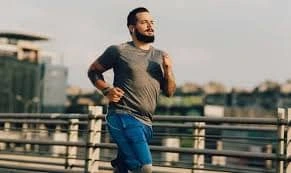


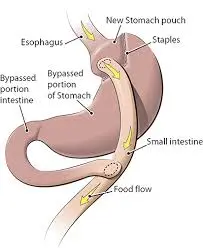
2 Comments